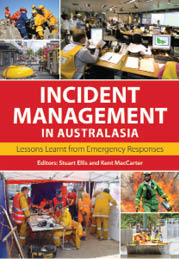
By Dr Valerie Ingham, Charles Sturt University

Edited by Stuart Ellis and Kent MacCarter
CSIRO Publishing: Clayton, Victoria
ISBN 9781486306176
Despite the encouragement to do so, it is a brave person who writes of their ‘could have done better’ moments for public release. The Australiasian Fire and Emergency Service Authorities Council and the book’s ten contributors have recognised the need to move beyond blame and better prepare aspiring incident managers through a frank reflection on the thoughts, feelings, fears and triumphs associated with tough incident management.
The book is a compilation of experience, exhilaration and warning and it makes inspiring reading. All contributors clearly present their organisation and jurisdiction to provide readers with their situational context. Systems, processes and acronyms are briefly outlined and minimal pre-knowledge is assumed. As the editor, Ellis states that this book is not to be viewed as academic, but rather it contains the stories of incident managers.
Each contributor puts their heart on the line to explore a particularly challenging incident in which they were heavily involved. The book is specifically compiled for those who are hungry for the inside story of incident management. It is also for those aspiring to lead in catastrophic unpredictable situations where decisions must be made rapidly with sparse pieces of information, conflicting reports and lots of background ‘noise’. Each of the ten incidents takes the writer ‘beyond our knowledge, skills, experience and imagination’ (Crosweller, p. 175). The lessons learnt across the book move from the subtle echoes of warning and caution to obvious enthusiasm for the job of incident management.
Euan Ferguson and Mark Crosweller engage themselves in every page, revealing thoughts and reflections not evident in the report writing style of other contributors. The range of writing styles is a strength of the book. In the Wangary Fire (Chapter 1) Ferguson explains how he negotiated the public – private terrain of self-management. The account of the Hobart Myer building fire by Gavin Freeman is a fast-paced narrative of a difficult to decipher fire. Freeman is a natural story teller and his gripping description is interspersed with wry humour.
Trevor White’s reflection on the 2011 Victorian floods provides a candid description of the triumphs and failures of communicating information and warnings to the community. White also provides a helpful progress report on changes made since the Victorian floods. This significantly strengthens his contribution as the reader can see the application of lessons learnt, a feature shared by Greg Leach (Linton fires), but generally absent for other chapters. Bob Conroy’s description of firefighter entrapment during a routine hazard reduction burn at Mount Kuring-Gai Kuringai is a sobering recount of tragic events. His poignant lessons learnt focus on the nature of gruelling inquiries and public scrutiny, providing a cautionary note to all aspiring incident managers. Other chapters range from a chemical spill (Leigh Swift), a petrochemical fire in Adelaide (Roy Thompson), a couple of floods (Bundaberg, John Watson) and Stuart Ellis contributes from the 2011 Christchurch earthquake.
Quite unselfconsciously this book reflects the struggle of Australian emergency services to realign a male dominated arena, as there are no female contributors. Readers are not made privy as to how contributors were selected. Was it magnitude of incident? diversity of incident? volunteered to write?
A fuller introduction, including an encapsulation of the brief provided to the writers, and whether the chapters are designed to be read sequentially or in any order for maximum benefit, would better situate readers. In addition, the book was weakened by the missing last chapter. In such a challenging and complex collection of incidents I would not expect a simplistic compilation of ‘lessons learnt’, however some effort could have been made to debrief the common and disparate chapter threads into a concerted appeal for the future development of incident managers. This would have strengthened the purpose and application of the work as a whole.
Case studies naturally lend themselves to reflection and lessons learnt. I feel certain that any number of educational programs will greatly benefit by assigning readings from this book. I highly recommend Incident Management in Australasia: Lessons Learnt from Emergency Responses as a candid reflection on leadership in time-pressured incidents.